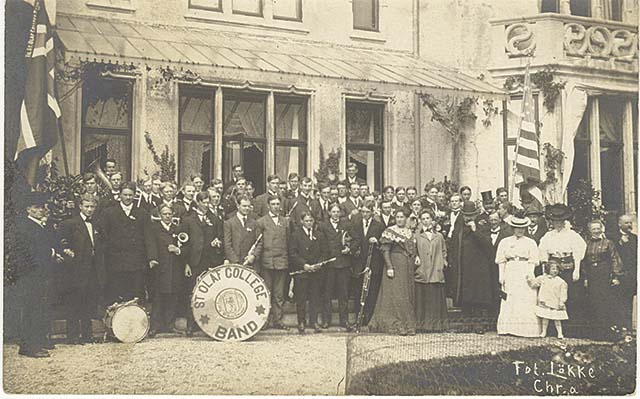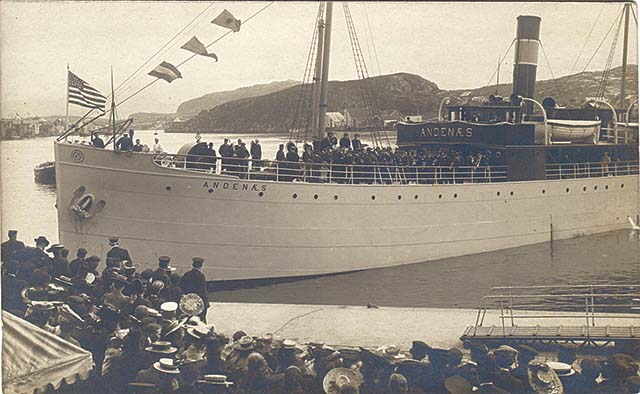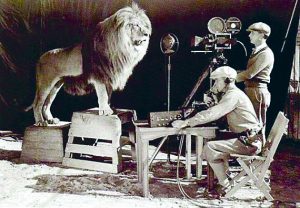
Visitors to Northfield’s third Vintage Band Festival this month may be acquainted with the name of F. Melius Christiansen, founder and director of the world renowned St. Olaf Choir from 1912 to 1943. But they and local area residents alike may be unaware of his association with bands and instrumental music.
Fredrik Melius Christiansen was born into a family of music lovers on April 1, 1871, in Berger, Norway, near Eidsvold. Joseph M. Shaw, in The St. Olaf Choir: A Narrative (1997), recounts that Christiansen’s maternal grandfather, Jon Braaten, was “a capable violinist and organist” who “laid down the rule that any young men calling on his daughters must play an instrument.” So Christiansen’s father Anders learned to play cornet, trombone and the bass viol as he courted Oleana Braaten. When they lived in the village of Agnes, Anders (a mechanic) led a factory band in which six-year-old F. Melius played a three-key clarinet he had received at the age of three. After the family settled in Larvik in 1879 where Anders worked for the glassworks, Anders and sons Karl and F. Melius joined the Larvik Band.
In Larvik, Christiansen’s musical abilities were encouraged as he took piano, organ and violin lessons. He became so proficient that, at the age of 12, he played a violin solo at a concert and, at 14, was able to fill in as church organist. He also began giving music lessons himself and composing pieces for small bands. But after the death of his mother in 1885 and the emigration to the U.S. of his brother Karl in 1887, Christiansen left for America in 1888. After a short stay with an uncle in Oakland, he joined Karl, who was working as a mechanic in a sawmill and directing a Scandinavian band, in Washburn, Wisconsin. Soon he was playing the baritone in the band and learning English at the local high school.
In the fall of 1890, at the age of 19, Christiansen was hired to be director of the city band in Marinette, Wisconsin. He gave piano, organ and violin lessons and became organist and choir director at a Lutheran church where he met his future wife, Edith Lindem. Two years later, Christiansen decided to further his education at Augsburg College and Seminary in Minneapolis after a concert at his church by a male quartet from this school.
With plans to become a concert violinist, Christiansen spent just one year at Augsburg before enrolling in the Northwestern Conservatory of Music in Minneapolis, from which he graduated in 1894 at the top of his class of 70 students. He directed a student chorus and was organist and choir director at a church near Augsburg, while taking advantage of a growing and active musical climate. Christiansen was in demand as a violinist and performed for various groups, including Norwegian-American social clubs.
On July 14, 1897, Christiansen and Edith Lindem were married in Marinette and moved to Leipzig, Germany, for two years so Christiansen and his brother Karl could study music at the Royal Conservatory of Music. Dr. Shaw, St. Olaf historian, points out that Christiansen’s first concern was the violin, which he practiced for six hours a day, with no choral studies at that time.

After receiving his diploma in the spring of 1899, Christiansen joined the violin faculty at Northwestern Conservatory and played violin in the Philharmonic orchestra which became the Minneapolis Symphony in 1903. While directing a male singing society, the Kjerulf Club, Christiansen met an extraordinary bass singer, Paul G. Schmidt, who became an assistant teacher of mathematics in 1902 at St. Olaf College and later manager of musical organizations.

In June of 1903, St. Olaf College president John N. Kildahl finally (on the third attempt) received permission to hire a music director from the United Norwegian Lutheran Church, which supported St. Olaf. Schmidt suggested Christiansen’s name to Pres. Kildahl and Christiansen accepted the position on a part-time basis, keeping his family in Minneapolis that first year. His duties were to head the music department, direct the band and the chorus and teach violin and music theory for $600 a year.
Music had been part of St. Olaf since its inception in 1874 as a co-educational academy founded by pastor Bernt Julius Muus from Norway. Instruction in piano, organ and note reading was offered during the inaugural term. The first notable music organization to emerge was the St. Olaf Band, which began as a 14-member cornet band at the college on Oct. 5, 1891, and played for commencement ceremonies and gave popular concerts in Northfield’s City Park (starting in 1893). It became a concert band with woodwinds under Andrew Onstad, the first salaried director from 1899 to 1903. In 1899, a Choral Union was organized by Oluf Glasoe.

Christiansen took over both the Choral Union and the band, with his primary focus on the 46-member all-male band. As Dr. Shaw writes, “It is well known that when F. Melius Christiansen came to St. Olaf in 1903 he took as his first project the improving of the Band. Decades later, while serving as guest conductor of the St. Olaf Band, he told its members, much to their delight, that the Band was his first love.”
Schmidt attended early rehearsals of the band and, in My Years at St. Olaf (1967), he writes that the band was used to playing one piece after another “just for the fun of it.” Christiansen, however, was “not at all impressed by the fact the band could play some marches from beginning to end without any noticeable mishap, but made every effort to improve tone quality and balance in the different sections, spent a great deal of time in repetition of certain musical phrases, and – what really surprised some of them – took time to show them how to handle and finger their instruments most effectively.” Leola Nelson Bergmann, in Music Master of the Middle West (1944), writes that Christiansen was the most “electric personality” they had ever seen “with his sharp, darting eyes, flushed face and vigorous movements.” Christiansen “demanded their best, drove them fiercely. But, though somewhat terrorized by him, the boys came to admire him unrestrainedly.” After a dozen rehearsals, they could see real progress under their new master director. He increased and improved their concert repertoire and also added marching rehearsals in uniform, with Schmidt serving as drum major. By November the Manitou Messenger said that “interest for the art melodious has taken an upward shoot, and our various musical organizations are in a flourishing condition.”
As a climax to his successful first year, Christiansen organized the college’s first musical festival on May 17-18, 1904. On May 21, the Northfield News called the festival “an immense success” and trumpeted in a headline Christiansen’s “Untiring Efforts and Superior Skill as a Leader in Music.” Festivities on the 17th included a baseball game on campus attended by 2,000 in the afternoon (won by Luther College) and a St. Olaf College Band concert downtown in the evening in a packed Ware Auditorium (now the Grand). The program included the Sextet from Lucia by Donizetti, The Blue Danube by Johann Strauss, F. Melius Christiansen’s own Norwegian Rhapsody and the Tancred Overture by Rossini. The News said “encore after encore was demanded.”
On the 18th the St. Olaf Choral Union led by Christiansen presented Haydn’s oratorio The Creation at the Ware, accompanied by the Danz Symphony Orchestra of Minneapolis. The Northfield News raved, “This occasion was the first the citizens of Northfield and vicinity ever had to hear as large a chorus, accompanied by an orchestra of any repute. It was a feat for the musicians and from the first strains of the introductory the audience was held almost spellbound.” Christiansen had found his life’s calling in Northfield.

On May 27, 1905, a touring Student Singing Society from the University of Christiania in Norway stopped by Northfield. Schmidt wrote that before the afternoon concert at the Ware Auditorium, the singers were treated to a lunch on the lawn of Ytterboe Hall: “Two things especially seemed to interest them greatly – the heaping bowls of fresh strawberries and cream and the playing of the band.” Christiansen had arranged some favorite Norwegian music and the visitors were so impressed that they urged their American tour manager, Harry Randall, to arrange a tour for the St. Olaf Band to Norway. Randall persuaded a Minneapolis businessman (Olaf Searle of the Scandinavian American Steamship Line) to make up any deficit.

Thus it was that the St. Olaf Band became the first U.S. college musical organization to tour in Europe in July of 1906. They played six concerts en route to New York, including in Chicago and Brooklyn and, on June 20, they left for Norway on the Oscar II steamship. After some days of seasickness in their steerage berths, the band reached Kristiansand on July 1st and continued along the coast to Christiania (now Oslo) the next day. As they neared the city, small cannon blasts from the boat were answered by cannon booms from the Askerhus Fortress on shore.
The student chorus from 1905, at the head of a tremendous crowd, greeted the band by singing the Star Spangled Banner and the band responded by playing the Norwegian national anthem, Ja vi elsker. The band then marched to the Mission Hotel and spent the next few days recuperating from their voyage, rehearsing and (on July 3) enjoying a dinner banquet with the student chorus at Holmenkollen, a mountain resort outside of town.
On the afternoon of the 4th of July the band boys showed off the American game of baseball, with a fencing mask serving as a catcher’s mask. Schmidt reported that “So far as we were able to judge from remarks made after the game, most people in the audience thought the game too dangerous, especially catching high flies.” One of the band boys said, “There were lots of grandstand stunts and some good plays, but it wasn’t the kind of game that wins pennants.”
That evening came the first concert in Tivoli, an open air amusement park. The band was to march, playing Alexander’s Olympia Hippodrome March, from their hotel to the site but needed police to clear their way through the tightly packed crowds that had gathered. More than 6,000 people enjoyed the sold-out concert, with one newspaper saying, “It is entirely unique that so young amateurs have been able to attain so much. Mr. Christiansen is apparently a conductor by the grace of God; there is inspiration in his baton.”
In addition to marches by Alexander and Sousa and the national anthems of both countries, the band’s repertoire included Christiansen’s Norwegian Rhapsody, Donizetti’s sextet from Lucia, Elsa Entering the Cathedral from Wagner’s Lohengrin, the William Tell Overture and Tancred Overture by Rossini, Schumann’s Traumerei, Macbeth’s Love in Idleness, Delibes’ Intermezzo and Grieg’s Landsighting. The soprano soloist Beatrice Gjertsen of Minneapolis sang Gounod’s Jerusalem, Sullivan’s The Lost Chord and songs by Schumann, Hawley and Martens.
At a stop at Eidsvold, the site of Norway’s Independence Hall, Schmidt recounted that an official was so overcome by the “sudden, thunderous rolling of the drums” as the band played the Norwegian anthem that he fell to the ground in a “quivering faint.” He later admitted that it was “the most stirring music he had ever heard and altogether too exciting for him.”
In Trondhjem (now Trondheim) King Haakon asked the band to play for the royal family, including the queen and crown prince Olav. Prior to a concert in the cathedral where the king had been recently crowned, the band gathered in the cemetery there to honor St. Olaf founder, the Rev. B.J. Muus, buried in his homeland. At Trondhjem the band boarded the boat Andenaes which became their home for 17 days as they played in coastal cities. Near Bergen, the band was welcomed to the palatial summer villa Gammelhaugen by Prime Minister Christian Michelsen and his wife (Michelsen had presided over the separation of Norway from Sweden). And in Stavanger, they were invited to help themselves to canned fish of the famous Bjelland’s Cannery.
A highlight for the band and for Christiansen was the stop in Larvik on July 21. The Larvik newspaper said: “We remember him well as a boy…On every 17th of May, and also on other festive days, we saw the little fellow march along with our city band. Later in life, like so many other talented Norwegian boys, he felt the urge to cross the high mountain in order to get more air under his wings. And now he returns to his boyhood home town, a grown-up man, who has brought glory and honor to the land of his birth.” Christiansen’s father proudly watched his son receive a silver Viking ship at a dinner after the concert.
Schmidt said the band had been a revelation to the people, since there was limited instrumentation in Norway. The band introduced the saxophone to the country, played by Herman Roe who later became the editor and owner of the Northfield News.
Before they boarded the ship back on July 29, the band played three more concerts in Christiania, including one before the local Temperance Society. The Society was quite impressed that the bandsmen were all abstainers. One of the players said, “The drinking class considered our attitude as highly ridiculous; the temperance people considered it as the height of perfection.”
It had been a tour of 57 days, with about 10,000 miles of travel and 30 concerts in Norway.

Christiansen led another noteworthy band tour in 1909 from Northfield out to the Alaska-Yukon-Pacific Exposition in Seattle. This time the band played 100 concerts in 69 towns in 105 days, covering 5,083 miles. The $10,000 expenses were made up for in concert receipts.
The band left June 21st by train on a private tourist sleeper through Northern Minnesota, North Dakota, Montana and Idaho. They played at auditoriums and opera houses en route to Spokane (occasionally taking on local baseball teams, as well). In Spokane, they had a week’s engagement to play two concerts a day at the Natatorium Amusement Park. The band was hosted by United Church people and the park averaged 3,000 per day, the best attendance that summer.
In Seattle, the highlight event was on August 30 when the St. Olaf Band led the mile-long parade celebrating Norway Day at the Alaska-Yukon-Pacific Exposition, a world’s fair publicizing the development of the Pacific Northwest. The parade, with sections representing periods of Norway’s history, went through the exposition grounds to an amphitheater where an afternoon program of speeches and band music took place. The band also had concerts in Everett, Tacoma, Silverton and Portland before a final appearance back in Spokane. Upon their return to Northfield, the Northfield Independent of Sept. 16, 1909, called it “the most successful and most extensive tour yet made,” with favorable press notices all along the way.
In 1919, Christiansen turned over band directing duties to J. Arndt Bergh and devoted his energies to the St. Olaf Choir, which he founded in 1912. A tour to the east coast in 1920 led to widespread critical acclaim for the St. Olaf Choir which has continued to this day. Christiansen became a legendary choir director, composer and arranger (his arrangement of Beautiful Savior being the best-known and the signature a cappella song of the Choir). His son Olaf Christiansen succeeded him as Choir director in 1943. F. Melius Christiansen died on June 1, 1955, in Northfield.

When the St. Olaf Choir returned from that first triumphant east coast tour in May of 1920, Christiansen spoke to the crowds that had gathered to welcome them back. He said, “The choir and band are a natural outgrowth of the culture here. They have grown naturally from a little seed way back in history and like flowers in the woods, grew under favorable conditions. That we were successful was only that the flavor of St. Olaf was given to the world and they seemed to like it.”
Years later, a visiting choir director who had been watching rehearsals of the St. Olaf Choir asked Christiansen, “How do you do it?”
Christiansen replied, “Work. Hard work. Did you think that God whispered in my ear?”
Perhaps Christiansen’s success with both the St. Olaf Band and Choir can be attributed to the flavor of St. Olaf, hard work–and divine inspiration, as well.
Thanks to St. Olaf archivist Jeff Sauve and St. Olaf historian Dr. Joseph Shaw for their contributions to this story. I was privileged to play alto clarinet in the St. Olaf Band’s 1966 European tour, under director Miles Johnson, celebrating the 60th anniversary of Christiansen’s historic 1906 band tour to Norway.






